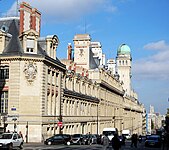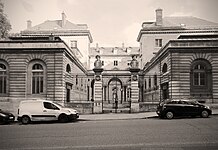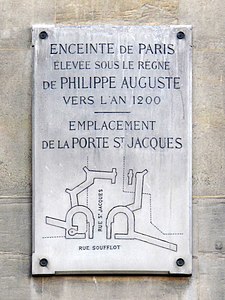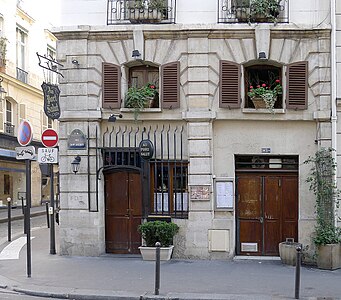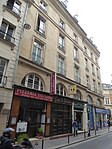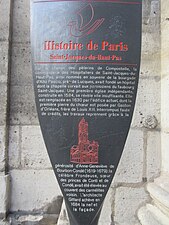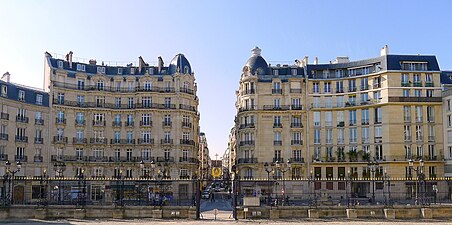Rue Saint-Jacques (Paris)
| Rue Saint-Jacques | |
|---|---|
| location | |
| Arrondissement | 5. |
| quarter | Sorbonne Val-de-Grâce |
| Beginning | 79, Rue Galande and Rue Saint-Séverin |
| The End | 84, Boulevard de Port-Royal |
| morphology | |
| length | 1550 m |
| width | 20 m |
| history | |
| designation | 1806 |
| Original names | Via Superior Grant-Rue Grant-Rue-Oultre-Petit-Pont and 9 other names |
| Coding | |
| Paris | 8871 |
The Rue Saint-Jacques in Paris runs on the Rive Gauche of the Seine in the 5th arrondissement .
course
It starts at 79 rue Galande , crossed in the 5th arrondissement
- the Quartier de la Sorbonne (No. 1 to 161 and 2 to 184)
- the Quartier du Val-de-Grâce (numbers 163 to 307 and 196 to 350)
and ends after 1550 meters at 84 Boulevard de Port-Royal
At its northern end, it turns into Rue du Petit Pont , which meets the Petit-Pont after 60 meters , and at its southern end into Rue du Faubourg Saint-Jacques , making it the old arterial road to Étampes and Orléans , before it was replaced by the urban planning measures of Baron Haussmann in the mid-19th century by the Boulevard Saint-Michel 200 meters further west.
The rue Saint-Jacques u. a.
- the Boulevard Saint-Germain
- the rue des Écoles
- the rue Soufflot and
- the rue Gay-Lussac
Rue Saint-Jacques can be reached with the RER B line via the Saint-Michel - Notre-Dame , Luxembourg , Port-Royal stations , the Cluny - La Sorbonne metro ![]() station and the Paris bus routes 21, 27, 38, 82, 84, 85 , 89, 91.
station and the Paris bus routes 21, 27, 38, 82, 84, 85 , 89, 91.
Name origin
The name comes from the former monastery of Saint-Jacques , which was given to the Dominicans (Ordo fratrum Praedicatorum - Ordre des Prêcheurs) in the 13th century , and who have also been called Jacobins in France since then . Rue Saint-Jacques is the southern part of the ancient Cardo Lutetias .
It had many names before it became Rue Saint-Jacques in 1806 :
- Grand'rue du Petit Pont (12th century)
- Grand'rue Saint-Jacques des Prêcheurs
- Grand'rue Saint-Etienne des Grés
- Grand'rue Saint-Benoît Le Bestournet
- Grand'rue près du chevet de l'Eglise Saint-Séverin
- Grand'rue oultre Petit Pont ou rue outre Petit Pont
- Grand'rue vers Saint-Matelin
- Grand'rue Saint-Benoît, and
- Grand'rue Saint-Jacques
history
Antiquity
The former Gallic road became the Gallo-Roman north-south axis with the name Via Superior . The 9 m wide and well-paved street led from Genabum (Orléans) from Rue des Feuillantines to Boulevard de Port-Royal . The route corresponds to the southern part of the Cardo in the former Lutetia , the Roman city whose center was in the current Latin Quarter ( Jardin du Luxembourg , Pantheon ). It is located in the extension of Rue du Petit-Pont , which continues to the south on Rue du Faubourg-Saint-Jacques .
middle Ages
In the Middle Ages this was the main artery connecting Paris with Étampes and Orléans . The connection was used by the many pilgrims who came to Santiago de Compostela from the Église Saint-Jacques-la-Boucherie (today only the Saint-Jacques tower remains ) through the Rue Saint-Jacques, the Faubourg Saint-Jacques and the Rue de la Tombe-Issoire on their way.
The street has changed its name very often: in the 12th century it was called "Grant-Rue-Oultre-Petit-Pont", "Grand'rue du Petit-Pont"; Around 1280–1300 it is quoted in Le Dit des rues de Paris by Guillot de Paris as “Grant-Rue”. In the 13th century it took on the following names in sections: "Grand'rue Saint-Jacques-des-Prêcheurs", "Grand'rue Saint-Étienne-des-Grès ", "Grand'rue Saint-Benoît-le-Beslournet", “Grand'rue près du chevet de l'église Saint-Severin”, “Grand'rue outre Petit-Pont”, “Grand'rue vers Saint-Mathelin”, “Grand'rue Saint-Benoît”, finally “Grand'rue Saint-Jacques »for the Chapel of St. James, where in 1218 the Dominican religious, then called the Jacobins, settled in a building that became the Jacobin monastery and remained until 1790. This street up to rue de la Bourbe has been called rue Saint-Jacques since 1806 .

The rue Saint-Jacques formed the border with the Garlande fiefdom .
The Porte Saint-Jacques in the Paris city wall by Philippe Auguste ( Enceinte de Philippe Auguste ) was between the Rue Soufflot and the Rue des Fossés-Saint-Jacques . The city gate is also called “Porte Notre-Dame-des-Champs” because you cross it to get to the suburb and monastery of the same name. On April 13, 1436, Charles VII's troops marched through here to liberate Paris from the English. - The gate was demolished in 1684.
More modern times
On September 4, 1557, the street became the scene of the event known as the Affaire de la rue Saint-Jacques , a bloody prelude to the Huguenot Wars .
From the 16th to the 18th century, the first printers and letterpress printers such as Soleil d'Or and Trois Cigognes concentrated here . All printers and booksellers in Paris were ordered by the decree of April 1, 1620 to confine themselves to the university district around the rue Saint-Jacques and not to cross the rue des Noyers under penalty of death. As a result, the street also became the seat of many engravers: Guillaume Chasteau , Laurent Cars , Étienne Jehandier Desrochers , Edme Jeaurat , Jean-Baptiste Scotin , Noël Le Mire , Jean-Jacques Le Veau , Charles-François-Adrien Macret , Clément-Pierre Marillier or Simon Thomassin .
After 1806
Until 1806, the Rue Saint-Jacques was limited to the part within the city wall of Philippe Auguste . The southern end was at the former Porte Saint-Jacques (demolished in 1684), where the Rue Soufflot and Rue des Fossés – Saint – Jacques flow today. From here on, the current Rue Saint-Jacques was called Rue du Faubourg-Saint-Jacques.
The Rue Saint-Jacques was lengthened by the Rue du Faubourg-Saint-Jacques to the Rues de la Bourbe and the Couvent des capucins du faubourg Saint-Jacques , which are now lost from the Boulevard de Port-Royal (built between 1857 and 1867) .
The street lost its importance when the Boulevard Saint-Michel was opened under the Prefect Georges-Eugène Haussmann . It ran parallel to Rue Saint-Jacques only 200 m to the west and was much wider.
The narrow and curvy Rue Saint-Jacques was widened in its northern part by decree of 1855 (renewed in 1907). the old even-numbered houses on the street side were demolished to expose the Église Saint-Séverin. On the other hand, many houses have been preserved.
With the construction of the new Sorbonne (1893–1897) and the facade of the Lycée Louis-le-Grand (1895–1898), the road was widened as it climbed to the Montagne Sainte-Geneviève. Between Rue Soufflot and Rue Gay-Lussac, the street retains its medieval narrowness. The somewhat set back houses of more recent date reinforce the irregularity of the route
Boulevard Saint-Michel and Rue Saint-Jacques are both one-way streets (in the lower part of the boulevard) and thus form a thoroughfare for traffic in Paris.
Remarkable buildings
- House No. 5 to 25: old houses
Gargoyles on the rue Saint-Jacques side.
- the Sorbonne (No. 36–56)
- the Collège de France at Place Marcelin Berthelot 11
- the Lycée Louis-le-Grand (No. 123)
- Entrance to the Legal Department ( Faculté de Droit )
- House number 151bis: Hôtel Lepas-Dubuisson ; the building juts out into the street and stands on the former site of the Porte Saint-Jacques
- (no longer existent) the Jacobin monastery (No. 156), in whose church (where the Rue Cujas is today) several members of the royal family were buried.
- (no longer existent) the most frequented city gate of Paris, the Porte Saint-Jacques (about at no. 157), as well as shortly after
- the Rue des Fossés Saint-Jacques as a relic of the (filled in) moat
- House No. 159: In the place where a pastry-chocolatier has a shop today, the bookseller Royol was in the 14th century with his book rental, while Victor Hugo and his brother Eugène also enjoyed long reading hours in 1812/13 spent. Louis-Joseph Girard , professor at the École nationale supérieure des beaux-arts de Paris, lived here in 1835 . The composer Joaquín Rodrigo also lived here; a plaque reminds of it.
- House number 163: Port du Salut : a former hostel, then a cabaret, now a restaurant. The carved letters (FDT) on the corner of the facade mark the border of the former feudal district Fief des Tumbes , which until 1789 belonged to the bishop or the sisters of the Order of the Visitation .
- House nos. 172 and 174: this is where the fundamental point for the Gallo-Roman Lutetia was located ; it was the highest point from the hill of St. Genoveva and the southeast corner of the Forum de Lutèce .
- House number 174: birthplace of the art dealer Paul Durand-Ruel
- House No. 187: Rental house from 1788, built by the architect Marie-Joseph Peyre
- House number 191: Institut de geographie , built by the architect Henri-Paul Nénot between 1914 and 1926 on the site of the former Couvent de la Visitation Saint-Jacques du Faubourg Saint-Jacques monastery , which was demolished in 1908.
- House number 195: Institut océanographique de Paris , founded by Albert I (Monaco) . The building was built in 1910 by Henri-Paul Nénot and declared a monument historique in 2004 .
- House number 200: The Charcuterie du Panthéon , built between 1914 and 1920, designed by Renato Panzani and named Monument historique in 1985.
House number 187, built for the Couvent de la Visitation
House number 191, Institut de geographie
House number 195, Institut océanographique de Paris
- House No. 250: The chemist Joseph Le Bel lived in the house from 1903 to 1930 and donated it to the Société Chimique de France ; a plaque commemorates him.
- House number 252: Saint-Jacques-du-Haut-Pas parish church
House number 252: St-Jacques-du-Haut-Pas .
- House number 254: Upcoming St. Jacques-du-Haut-Pas
- House No. 277: Military hospital and former Val-de-Grâce monastery
- House No. 279: Église Notre-Dame du Val-de-Grâce , attached to the military hospital ; on the opposite side the street widens to Place Alphonse-Laveran
Église Notre-Dame du Val-de-Grâce , facade facing Rue Saint-Jacques
Place Alphonse-Laveran seen from the Église du Val-de-Grâce.
The street in film and literature
In Georges Franju's film Eyes Without Face (1960), Edna Grüberg ( Juliette Mayniel ) discreetly identifies young girls on this street, at the exit of the Sorbonne University , who are used as scientific guinea pigs for Dr. Génessier ( Pierre Brasseur ).
In the novel Sentimental Education by Gustave Flaubert lives Baptiste Martinon, former Kamarad Frédéric, in this street.
Web links
- Extrait de la nomenclature officielle des voies de Paris ( Memento of January 8, 2006 in the Internet Archive )
literature
- Adélaïde Barbé, Guide Bleu de Paris , Paris, Hachette Livre , 1987, ISBN 2-01-011485-X
- Louis Capitan , "La dernière réfection en dalle de grès de la voie romaine de Lutèce à Genabrum dans sa traversée de Paris", in Comptes-rendus des séances de l'Académie des inscriptions et belles-lettres , vol. 2, 1921, p 85-90
- Jacques Hillairet and Pascal Payen-Appenzeller, Dictionnaire historique des rues de Paris , Paris, Éditions de Minuit, 1985, Vol. 2, I, 544 pp., ISBN 2707310549
- Félix Lazare and Louis Lazare, Dictionnaire administratif et historique des rues de Paris et de ses monuments , rue Saint – Jacques , 1844, BNF 32357628x
- M. Viré, "Paris gallo-romain: un nouveau fragment de la grande voie d'Orléans sous la rue Saint-Jacques", in Paris aux cent villages , No. 4, 1975, pp. 1 to 16
- Louis Adrien Huart : Quand on a vingt ans, histoire de la rue Saint-Jacques, Paris 1834
Individual evidence
- ↑ chevet = head end, here: choir
- ↑ Jacques Hillairet et Pascal Payen-Appenzeller, Dictionnaire historique des rues de Paris , Vol. 2, I, Paris, Éditions de Minuit, 1985, 8th edition, 544 pp., ISBN 2707310549
- ^ Louis Batiffol, La Vie de Paris sous Louis XIII , Éditions Calmann-Lévy, 1932, 232 pp.
- ↑ Alexandre Gady , La Montagne Sainte-Geneviève et le Quartier Latin , Hoëbeke, 1998, ISBN 9782842300678 , 55 pp.
- ↑ Hugo album, Editions Gallimard , edition “Bibliothèque de la Pléiade”, 1964, p. 24
- ↑ Guyot de Fère, Statistique des beaux-arts en France, annuaire des artistes français , Paris, 1835, p. 9
- ^ "François Villon à Paris et Meung" , view of the Terre des écrivains
- ↑ read: Fief des Tumbes 2
- ^ Didier Busson and Nicole Alix, Paris, ville antique, Center des monuments nationaux , 2001, ISBN 9782858223688 , p. 42
- ↑ Alexandre Gady, La Montagne Sainte-Geneviève et le quartier latin , Paris, Éditions Hoëbecke, 1998 ISBN 2 84230 067 X , p. 274
- ↑ Adélaïde Barbé, Guide Bleu de Paris , Paris, Hachette Livre , 1987, ISBN 2-01-011485-X . P. 614
- ↑ www.pop.culture.gouv.fr
- ↑ www.pop.culture.gouv.fr
Coordinates: 48 ° 50 ′ 48 ″ N , 2 ° 20 ′ 36 ″ E









